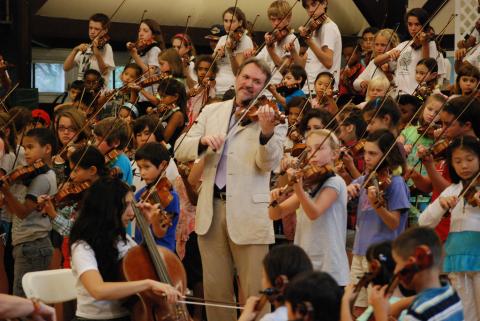Stop Forcing Your Kids to Learn a Musical Instrument
So why are so many children taking ballet, violin, piano? Lately, I have been asking my fellow middle-class urbanite parents that question. About dance, they say things like, “Ballet teaches them poise,” or, “Ballet helps them be graceful.” And about violin or piano they say, “It will give them a lifelong skill,” or, “They’ll always enjoy listening to music more.”
It does not take a rocket scientist, or a Juilliard-trained cellist, to see the flaws in these assertions. First, as to ballet, I propose a test. Imagine we took ten girls (or boys) who had studied ballet from the ages of five to twelve, and then quit, and mixed them in with ten girls (or boys) who had never taken dance. Let’s say that we watched these twenty tweens move around their schools for a day: around the cafeteria, the library, the gym, passing notes, sneaking out behind the middle school for a smoke, all the stuff tweens do. Does anyone really believe we could spot the ones who had spent seven years in weekly or biweekly ballet class?
I do not doubt that a ballet teacher or dance aficionado might spot some tell-tale moves—a slip into first position here or there, a certain elegance in a jump during a game of ultimate frisbee. And probably one or two of the ballet students, the best of them, really would appear more graceful than the others. But for the general mass of kids, the dance classes will not have had much impact on how they move. If you don’t believe me, then please visit a middle school in a wealthy town, watch children in the lunch line, and try to pick out which ones had studied ballet.
As for the enduring value of music lessons, I propose an even simpler test. Go on Facebook and ask your friends to chime in if, when they were children, they took five years or more of a classical instrument. Then ask all the respondents when they last played their instrument. I tried a version of this at a dinner party recently. There were about ten adults present; I was the only one who had not played an instrument for many years as a child. All of them confessed that they never played their instrument. Whatever it was—violin, piano, saxophone—they had abandoned it. The instrument sat lonely in a closet somewhere, or in the attic of their childhood home. Or their parents off-loaded it in a tag sale years ago.
And the music that these friends listen to as adults—klezmer, Indigo Girls, classic rock—is in each case quite far from what their parents paid for them to study. Their studies of cello had not made them into fans of Bach. And unless I am mistaken, Shinichi Suzuki didn't include Rush in his violin books.
Now it is clearly the case that if nobody studied ballet or violin, we would have no professional orchestras or ballet companies. That would be a great loss. But for such art forms to persist, it is only necessary that the most eager and gifted students persist in their studies. I’m all for lots of children trying classical music or dance, but we no more need millions of fourth-year violin students than we need millions of fourth-year origami students. We all love paper cranes, I think, but we aren’t rushing to give our children to the cause.
Before the twentieth century, there was a good reason for anyone to study music: If you couldn’t make the music yourself, then you would rarely hear it. Before the radio and the phonograph, any music in the house was produced by the family itself. So it made sense to play fiddle, piano, jug, whatever. And before urbanization and the automobile, most people did not have easy, regular access to concerts. Of course, small-town people could come together for occasional concerts, to play together or to hear local troupes or traveling bands. Growing up in the sticks, you still might see Shakespeare performed, and a touring opera company could bring you Mozart. But very infrequently. If music was to be a part of your daily life, it had to be homemade.
But there were other, more complicated reasons that people took up instruments, or forced their children to. As the historian Susie Steinbach writes in Understanding the Victorians, in the mid-nineteenth-century the piano, which had always been handmade and tended to reside in upper-class parlors, became an accessible, middle-class status symbol, as fit for a tradesman’s house as for Emma Woodhouse’s. “By the 1850s and 1860s many pianos were manufactured in Germany and in the United States as well as in Britain,” Steinbach writes, “and were made by machine; both changes made pianos less expensive.”
Changes in financing helped, too: The advent of the installment plan brought pianos to people who did not have vast capital. As the price of instruments dropped, music lessons became the burden of the well-bred girl, or of the girl whose parents hoped to massage some breeding into her.
Mark Oppenheimer

